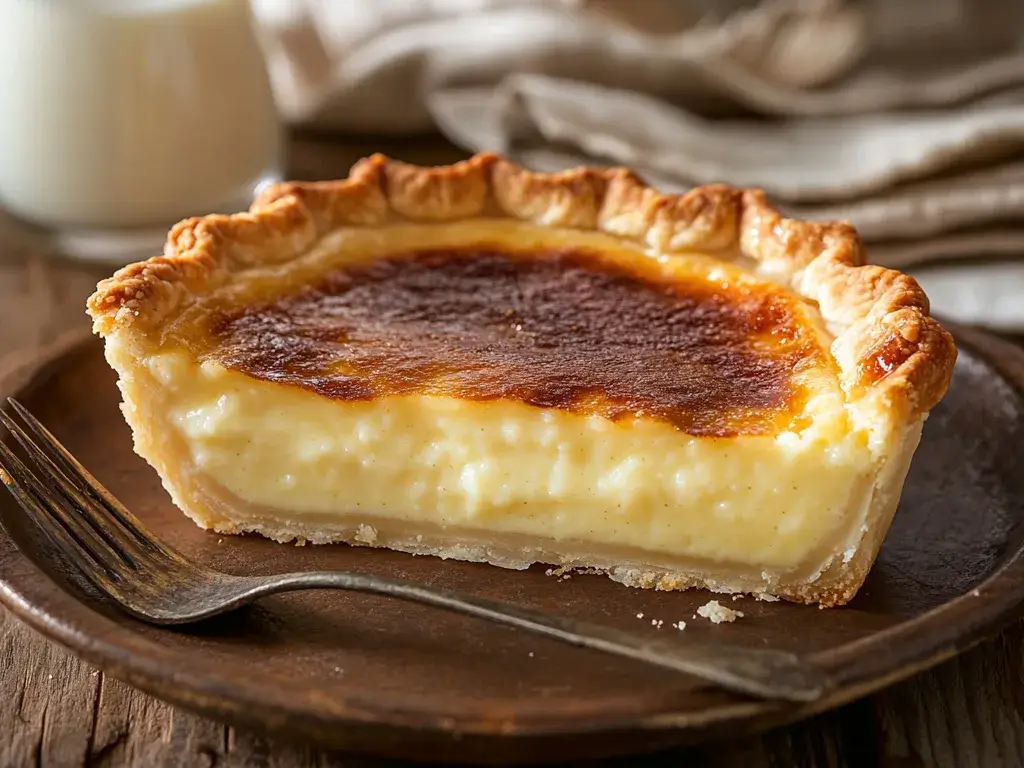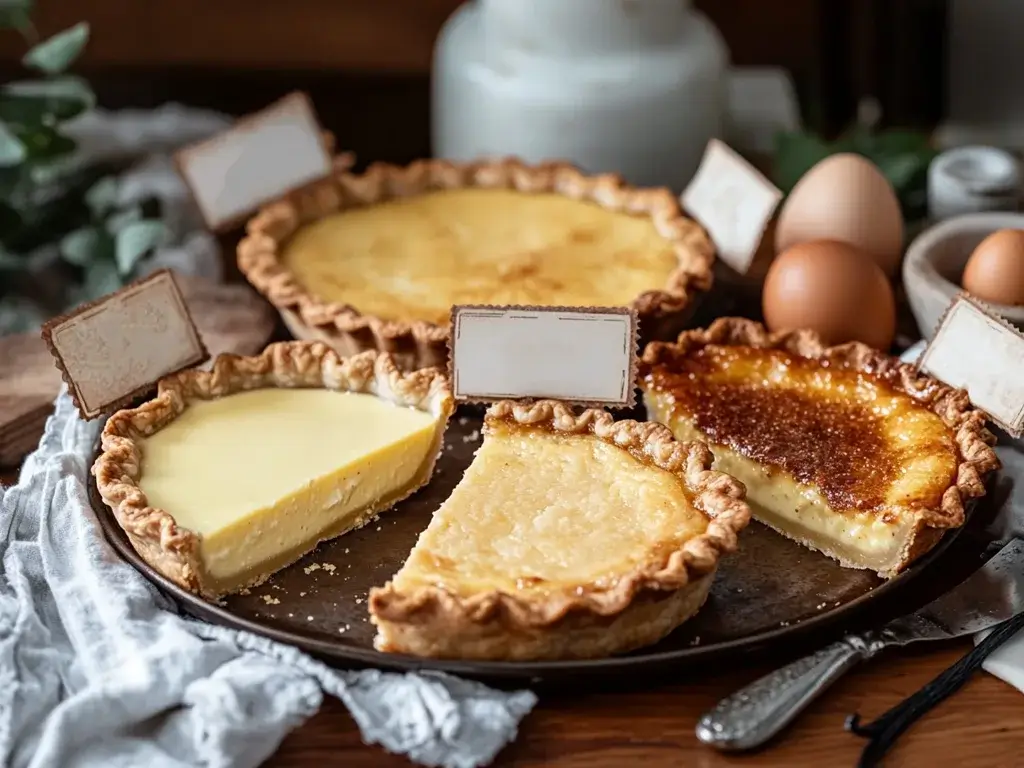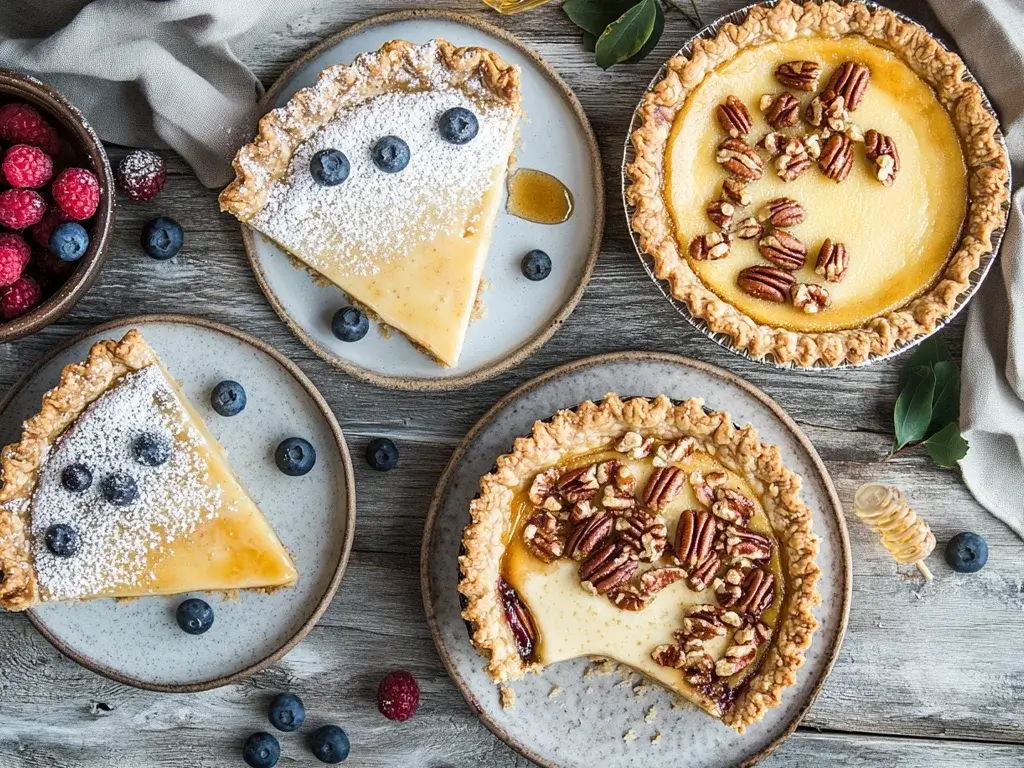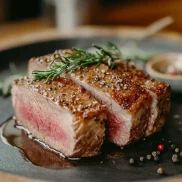If you’ve ever wondered, what does buttermilk pie taste like?, you’re not alone. This Southern classic has been delighting taste buds for generations, but its unique flavor and texture often leave first-timers curious. Buttermilk pie is a dessert that embodies simplicity and nostalgia, yet surprises with its complex and balanced flavor. With its creamy filling and golden crust, it’s a treat that feels like a warm hug in pie form. For an exciting twist on this classic dessert, check out Buttermilk Sweet Potato Pie for a creative variation. In this article, we’ll explore the rich history, defining ingredients, and unmistakable taste profile of buttermilk pie. By the end, you’ll understand why it’s a dessert worth savoring and sharing.
Table of Contents
Understanding Buttermilk Pie
Buttermilk pie is a dessert steeped in tradition and adored for its simple yet elegant charm. It is celebrated across generations for its comforting flavor and texture, making it a staple in Southern kitchens. Its unpretentious ingredients come together to create a dessert that feels both homey and refined, capturing the essence of Southern hospitality.
The Origin and History of Buttermilk Pie
Buttermilk pie has its roots in the culinary traditions of Europe, where custard-based desserts were a staple. When settlers brought these recipes to the United States, they adapted them to local ingredients, and buttermilk pie found its place in Southern kitchens. Its origins are tied to frugality and practicality, making use of pantry staples like eggs, sugar, and buttermilk. Unlike more elaborate desserts, buttermilk pie doesn’t rely on seasonal fruits or rare ingredients, which made it especially popular during times of scarcity.
Over the years, buttermilk pie became a hallmark of Southern hospitality. It graced the tables of family gatherings, church potlucks, and holiday feasts. The dessert’s longevity is a testament to its universal appeal and the comforting nostalgia it evokes. Today, buttermilk pie continues to be celebrated, with modern bakers adding their own twists while honoring its humble beginnings.
Key Ingredients That Define the Flavor
The magic of buttermilk pie lies in its simplicity. Each ingredient plays a crucial role in crafting the dessert’s distinct flavor. Here are the key components:
- Buttermilk: The star of the show, buttermilk provides a subtle tanginess that sets this pie apart from other custard-based desserts. It’s the ingredient that gives the pie its signature flavor.
- Eggs: Acting as a binding agent, eggs contribute to the pie’s smooth, custard-like texture. They also help balance the richness of the filling.
- Sugar: The sweetness of the pie comes from granulated sugar, which balances the tang of the buttermilk. Some recipes include brown sugar for a caramel-like depth.
- Butter: Melted butter adds richness and a velvety mouthfeel to the filling.
- Flour: A small amount of flour helps stabilize the custard, ensuring it sets properly without being too dense.
- Vanilla Extract: This adds a warm, aromatic sweetness that complements the other ingredients.
Optional additions like lemon juice or zest, nutmeg, and cinnamon can enhance the flavor, giving each baker the chance to make the recipe their own.
How Buttermilk Influences the Taste
Buttermilk is the ingredient that truly defines this pie. Its tangy, slightly acidic nature cuts through the sweetness of the sugar, creating a harmonious balance. The acidity of buttermilk also interacts with the eggs and flour during baking, giving the pie its creamy, custard-like consistency.
Moreover, buttermilk’s flavor is subtle but distinctive. It’s not overpowering, allowing the sweetness, buttery richness, and hints of vanilla to shine through. The result is a pie that’s neither cloying nor bland—it’s just right. If you’re a fan of desserts that walk the line between sweet and tangy, buttermilk pie is sure to delight your taste buds.
What Does Buttermilk Pie Taste Like? A Detailed Flavor Breakdown

Sweetness and Tanginess: A Perfect Balance
One of the most notable aspects of buttermilk pie is its balanced flavor profile. The sweetness from the sugar is pronounced but not overwhelming, while the tanginess from the buttermilk adds a refreshing contrast. This interplay of flavors makes each bite intriguing and satisfying. It’s a dessert that pleases those who love traditional sweet pies and those who prefer something with a bit more complexity.
The tangy undertone is particularly appealing because it prevents the pie from becoming too rich. Unlike overly sugary desserts, buttermilk pie feels light and palatable, even after a hearty meal. This balance is one of the reasons it has remained a beloved treat for generations.
Creamy Texture and Mouthfeel
Texture plays a huge role in the overall experience of buttermilk pie. The filling is incredibly creamy, with a consistency that’s firmer than a pudding but softer than a cheesecake. This custard-like texture is achieved through the careful combination of eggs, buttermilk, and butter.
When you take a bite, the filling practically melts in your mouth. It’s silky smooth, with just enough structure to hold its shape when sliced. The buttery crust provides a delightful contrast, adding a bit of crunch to the otherwise velvety texture. Together, the filling and crust create a harmonious mouthfeel that’s both comforting and luxurious.
Subtle Notes of Vanilla and Citrus
While buttermilk is the star, the supporting flavors elevate the pie to new heights. Vanilla extract adds a layer of warmth and sweetness that rounds out the tangy notes of the buttermilk. Some recipes also include a hint of citrus, often in the form of lemon juice or zest. This adds a bright, zesty element that complements the richness of the custard.
These subtle flavors make buttermilk pie more than just a sweet treat. They add depth and complexity, ensuring every bite is a little different from the last. Whether you’re savoring the vanilla-infused creaminess or detecting a whisper of citrus, the flavor profile is both dynamic and comforting.
Comparing Buttermilk Pie to Other Desserts

How It Differs from Custard Pie
Buttermilk pie and custard pie share many similarities, but their differences are what make each dessert special. Both feature a creamy filling, but custard pie tends to have a more neutral flavor profile, relying primarily on eggs, cream, and sugar. Buttermilk pie, on the other hand, introduces a tangy twist thanks to its namesake ingredient. This tanginess sets it apart, offering a more dynamic taste that balances sweetness with a subtle tartness.
The texture is another distinguishing factor. While both pies are smooth, custard pie often has a slightly firmer consistency. Buttermilk pie’s filling is silkier and creamier, thanks to the interplay of buttermilk and butter. The crusts are similar, though buttermilk pie’s rich filling pairs especially well with a buttery, flaky base.
Is Buttermilk Pie Similar to Chess Pie?
At first glance, buttermilk pie and chess pie appear nearly identical. Both are Southern favorites with custard-like fillings and golden crusts. However, their ingredients and flavors differ in subtle yet significant ways. Chess pie typically includes cornmeal, which adds a slightly gritty texture and a unique taste. It also tends to be sweeter and richer due to the addition of more sugar and sometimes corn syrup.
Buttermilk pie’s tanginess is its defining feature, setting it apart from the predominantly sweet chess pie. The absence of cornmeal also gives buttermilk pie a smoother consistency. While fans of one dessert often enjoy the other, their distinctive characteristics make them separate experiences worth savoring.
Buttermilk Pie vs Lemon Meringue: Key Differences
Lemon meringue pie and buttermilk pie couldn’t be more different, despite both having tangy elements. Lemon meringue pie is zesty and vibrant, with a sharp lemon flavor that dominates the palate. Its light, airy meringue topping contrasts sharply with the dense custard filling of buttermilk pie.
Buttermilk pie, by comparison, is subtler in its tanginess, offering a creamier, richer flavor profile. It lacks the citrusy punch of lemon meringue, opting instead for a balanced sweetness. The buttery crust and custard-like filling make it a heartier dessert, whereas lemon meringue feels lighter and more refreshing. Both pies shine in their own right, appealing to different taste preferences and occasions.
Variations in Buttermilk Pie Recipes

Regional Twists and Adaptations
Buttermilk pie has evolved as it spread across regions, with local adaptations adding unique twists. In the Southern United States, traditional recipes remain popular, featuring the classic blend of buttermilk, sugar, eggs, and vanilla. However, regional variations often include ingredients like nutmeg, cinnamon, or lemon zest to enhance the flavor.
In some areas, bakers experiment with the crust, using graham crackers or shortbread instead of the traditional pastry. Others incorporate regional ingredients, like pecans or peaches, for a distinctly local flair. These adaptations highlight the versatility of buttermilk pie, showing how it can be tailored to reflect different culinary traditions while retaining its core identity.
Popular Additions: Spices, Fruits, and More
While the classic buttermilk pie is a masterpiece on its own, many bakers enjoy experimenting with additional ingredients to create new flavor profiles. Spices like nutmeg, cinnamon, and allspice can add warmth and depth to the pie, making it even more comforting during colder months.
Fruits like blueberries, raspberries, or sliced peaches can be added to the filling for a burst of natural sweetness and color. Some recipes also include a splash of bourbon or rum, introducing a sophisticated twist that complements the tangy buttermilk. These variations ensure that buttermilk pie remains a versatile and exciting dessert, adaptable to any occasion or palate.
The Baking Experience
Preparing the Pie: From Crust to Filling
Making a buttermilk pie from scratch is a rewarding experience that combines simple ingredients with time-tested techniques. The process starts with the crust, which serves as the foundation of the pie. A buttery, flaky crust is essential, as it complements the creamy filling. Whether you choose to make your crust from scratch or use a store-bought option, blind baking it beforehand ensures it stays crisp and doesn’t become soggy from the filling.
The filling is the heart of the pie. It’s a straightforward mixture of buttermilk, sugar, eggs, melted butter, flour, and vanilla extract. Some recipes may call for additional ingredients like lemon juice or nutmeg for an extra layer of flavor. The key is to whisk the ingredients until smooth, avoiding overmixing, which can introduce air bubbles and affect the pie’s texture.
Once the crust and filling are ready, pour the mixture into the prepared crust and bake until the filling is set but still slightly wobbly in the center. Allowing the pie to cool completely before slicing ensures it holds its shape and allows the flavors to develop fully.
Common Mistakes That Affect the Flavor
While buttermilk pie is relatively easy to make, a few common mistakes can impact its flavor and texture. Here are some tips to ensure success:
- Overbaking: One of the most common pitfalls is overbaking, which can lead to a dry, rubbery filling. Keep an eye on the pie and remove it from the oven when the center is still slightly jiggly.
- Skipping Blind Baking: Failing to blind bake the crust can result in a soggy bottom. Blind baking creates a barrier that prevents the crust from absorbing moisture from the filling.
- Incorrect Measurements: Precision is key in baking. Too much sugar can make the pie overly sweet, while too little buttermilk can diminish its signature tanginess.
- Using Cold Ingredients: Ensure that your eggs and butter are at room temperature. Cold ingredients can lead to a lumpy filling and uneven baking.
By avoiding these mistakes, you’ll achieve a perfectly creamy, flavorful buttermilk pie every time.
Serving and Pairing Buttermilk Pie
Ideal Serving Temperatures
The temperature at which you serve buttermilk pie can significantly influence the eating experience. While it’s delicious at room temperature, serving it chilled allows the custard filling to firm up, making it easier to slice. Chilled buttermilk pie also highlights the tanginess of the buttermilk and the richness of the custard.
If you prefer a softer texture, slightly warm slices in the microwave for about 10-15 seconds. This releases the buttery aroma and makes the pie even more comforting. Ultimately, the best serving temperature depends on personal preference, but many agree that a chilled slice with a dollop of whipped cream is a classic choice.
Best Beverages to Complement the Flavor
Pairing buttermilk pie with the right beverage enhances its flavor profile and elevates the overall experience. Here are some popular choices:
- Coffee: A hot cup of coffee balances the pie’s sweetness and provides a pleasant contrast to its creamy texture.
- Tea: Light, unsweetened teas, such as green or Earl Grey, complement the tangy undertones without overwhelming the palate.
- Milk: For a nostalgic pairing, a glass of cold milk is a classic choice that brings out the pie’s comforting qualities.
- Dessert Wines: Sweet wines like Moscato or Riesling enhance the pie’s flavors, creating a luxurious dessert pairing. For more inspiration, check out Perfect Wine Pairings for Desserts.
These beverage options ensure that every bite of buttermilk pie is accompanied by the perfect sip, making the experience even more memorable.
Frequently Asked Questions
Why is my buttermilk pie watery?
A watery buttermilk pie is usually the result of underbaking or an incorrect balance of ingredients. If the pie is removed from the oven too soon, the custard doesn’t have enough time to set properly. Ensure the pie is baked until the center is slightly wobbly but not liquid. Additionally, double-check your recipe measurements, as too much buttermilk or insufficient flour can lead to a runny texture.
Why is my sweet potato pie soggy?
A soggy sweet potato pie often occurs due to a crust that hasn’t been blind-baked or over-moist filling. To avoid this, blind-bake the crust before adding the filling to ensure it remains crisp. Also, reduce the moisture in the sweet potatoes by draining them well or baking instead of boiling. Learn more
Can buttermilk pie be made ahead of time?
Yes, buttermilk pie can be made ahead of time. It actually tastes better when allowed to cool and set in the refrigerator for several hours or overnight. This preparation enhances the custard’s texture and flavor, making it ideal for gatherings.
How do I store buttermilk pie?
Store buttermilk pie in the refrigerator, covered with plastic wrap or foil, to maintain its freshness. It can last for up to 3-4 days when stored properly. Always serve it chilled or warmed slightly, depending on your preference.
Can I freeze buttermilk pie?
Yes, you can freeze buttermilk pie. Once it has cooled completely, wrap it tightly in plastic wrap and aluminum foil to prevent freezer burn. It can be stored in the freezer for up to 2 months. Thaw it in the refrigerator before serving.
What’s the difference between buttermilk pie and custard pie?
While both pies have a creamy texture, the main difference lies in flavor. Buttermilk pie has a tangy, slightly acidic taste due to the buttermilk, whereas custard pie offers a more neutral and straightforward sweetness. This distinction makes buttermilk pie more dynamic in flavor.
Conclusion
Buttermilk pie is a dessert that seamlessly blends simplicity with sophistication. Its rich history, versatile flavor profile, and undeniable charm make it a standout among Southern desserts. Whether you’re preparing it for the first time or revisiting an old favorite, buttermilk pie never fails to deliver warmth and comfort with every bite. From its creamy filling to its flaky crust, this classic dessert is a testament to the beauty of uncomplicated ingredients. Serve it chilled or warm, pair it with your favorite beverage, and enjoy the timeless delight of buttermilk pie.






